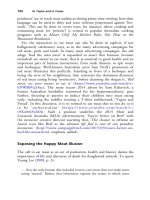The palgrave international handbook of a 506
Bạn đang xem bản rút gọn của tài liệu. Xem và tải ngay bản đầy đủ của tài liệu tại đây (26.6 KB, 1 trang )
Interventions with Animal Abuse Offenders
509
interest in this topic and who would be unlikely to sign up for an elective
course on it. If these practitioners come to recognize animal abuse as another
form of violent behavior that may be also connected to other problematic
behaviors and/or other pathology, developing their competency in animal
abuse intervention could be as straightforward as educating them on determining how the animal abuse is connected to the client’s other functioning
and incorporating this information into the interventions they already provide.2 Consequently, these practitioners may be more willing to take identified animal abuse cases, as well as to be proactive in addressing animal abuse
when it is not the identified focus of an intervention.
If animal abuse diversion programs and/or specialized animal welfare
courts are successfully replicated across the US, this too may solve part of
the “referral pipeline problem” and result in greater access to intervention by
offenders for whom it is appropriate. Another potential outgrowth of these
initiatives is that they may drive interest among clinicians in becoming
familiar with this area in order to take advantage of demand by the courts.
Selecting a Finer Paintbrush
When the present authors conduct training on animal abuse prevention/
intervention and ask participants to describe the first image that comes into
their heads when thinking of an “animal abuser,” the most common
response—particularly from lay audiences—is an adult man beating or
kicking a companion animal, such as a cat or dog. Yet the preceding
chapters of this book demonstrate that animal abuse is not a homogeneous
phenomenon. Rather, animal abuse can take multiple forms, within and
across such categories as physical, emotional and sexual abuse, and neglect;
it can be direct or indirect, and proximal (in close contact with the victim)
or distal; its victims can be companion, wild, or farmed animals; it can be
perpetrated by males or females of any age. Further, humans inflict harm
on animals for a variety of reasons: financial gain, ignorance, aggression,
retaliation, species prejudice, thrill, peer pressure, status, cultural practice,
and so on (see Kellert and Felthous 1985 and Vermeulen and Odendaal
1993, for a fuller review). These differing motivations for abuse may
themselves differ by gender: previous research by Gupta (2008) used
2
Nevertheless, we recommend that stopping the abusive behavior toward animals be explicitly addressed
even when it is not the intervention goal, and that animal abuse not be treated as a mere indicator.









